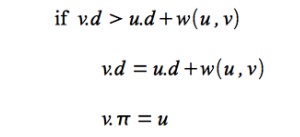Chapter: Programming and Data structures : Graphs
Bellman-Ford Algorithm
BELLMAN-FORD
ALGORITHM:
Single Source Shortest Path
Problem
Given a
directed graph G(V,E) with weighted edges w(u,v), define the path weight of a path p as

For a
given source vertex s, find the minimum weight paths to every vertex
reachable from s denoted

The final
solution will satisfy certain caveats:
┬Ę
The graph cannot contain any negative weight cycles (otherwise there would be no minimum path
since we could simply continue to follow the negative weight cycle producing a
path weight of -Ōł×).
┬Ę
The solution cannot have any positive weight cycles (since the cycle could simply be removed
giving a lower weight path).
┬Ę The solution can be assumed to have no zero weight cycles (since they would not affect the minimum value).
Therefore
given these caveats, we know the shortest paths must be acyclic (with Ōēż |V|
distinct vertices) ŌćÆ Ōēż |V| - 1 edges in each path.
Generic Algorithm
The
single source shortest path algorithms use the same notation as BFS with
predecessor ŽĆ and distance d fields
for each vertex. The optimal solution will have v.d =
╬┤(s,v)
for all v Ōłł V.
The
solutions utilize the concept of edge
relaxation which is a test to determine whether going through edge (u,v)
reduces the distance to v and if so
update v.ŽĆ and v.d. This is accomplished using the condition

Bellman-Ford Algorithm
The Bellman-Ford algorithm uses relaxation to
find single source shortest paths on directed graphs that may contain negative weight edges. The algorithm
will also detect if there are any negative
weight cycles (such that there is no solution).
BELLMAN-FORD(G,w,s)
1. INITIALIZE-SINGLE-SOURCE(G,s)
2. for i = 1
to |G.V|-1
3. for each edge (u,v) Ōłł G.E
4. RELAX(u,v,w)
5. for
each edge (u,v) Ōłł G.E
6.
if v.d > u.d + w(u,v)
7.
return FALSE
8. return
TRUE
INITIALIZE-SINGLE-SOURCE(G,s)
1. for
each vertex v Ōłł G.V
2.
v.d = Ōł×
3.
v.pi = NIL
4. s.d =
0
RELAX(u,v,w)
1. if v.d
> u.d + w(u,v)
2.
v.d = u.d + w(u,v)
3.
v.pi = u
Basically
the algorithm works as follows:
1. Initialize
d's, ŽĆ's, and set s.d = 0 ŌćÆ O(V)
2. Loop |V|-1 times through all edges checking
the relaxation condition to compute minimum distances ŌćÆ (|V|-1) O(E) = O(VE)
3. Loop
through all edges checking for negative weight cycles which occurs if any of
the relaxation conditions fail ŌćÆ O(E)
The run
time of the Bellman-Ford algorithm is O(V
+ VE + E) = O(VE).
Note that if the graph is a DAG (and thus is
known to not have any cycles), we can make Bellman-Ford more efficient by first
topologically sorting G (O(V+E)),
performing the same initialization (O(V)),
and then simply looping through each vertex u
in topological order relaxing
only the edges in Adj[u] (O(E)). This method only takes O(V +
E) time. This procedure (with a
few slight modifications) is useful for finding critical paths for PERT charts.
Example:
Given the
following directed graph

Using
vertex 5 as the source (setting its distance to 0), we initialize all the other
distances to Ōł×.

Iteration 1: Edges (u5,u2)
and (u5,u4) relax updating the
distances to 2 and 4

Iteration 2: Edges (u2,u1),
(u4,u2) and (u4,u3) relax updating the
distances to 1, 2, and 4 respectively.
Note edge (u4,u2) finds a shorter path to
vertex 2 by going through vertex 4

Iteration 3: Edge (u2,u1)
relaxes (since a shorter path to vertex 2 was found in the previous iteration) updating the distance to 1

Iteration 4: No edges relax

The final
shortest paths from vertex 5 with corresponding distances is

Negative cycle checks: We now
check the relaxation condition one additional time for each edge. If any of the checks pass then there exists a negative
weight cycle in the graph.
v3.d > u1.d + w(1,3) ŌćÆ 4 Ōē» 6 + 6 = 12 Ō£ō
v4.d > u1.d + w(1,4) ŌćÆ 2 Ōē» 6 + 3 = 9 Ō£ō
v1.d > u2.d + w(2,1) ŌćÆ 6 Ōē» 3 + 3 = 6 Ō£ō
v4.d > u3.d + w(3,4) ŌćÆ 2 Ōē» 3 + 2 = 5 Ō£ō
v2.d > u4.d + w(4,2) ŌćÆ 3 Ōē» 2 + 1 = 3 Ō£ō
v3.d > u4.d + w(4,3) ŌćÆ 3 Ōē» 2 + 1 = 3 Ō£ō
v2.d > u5.d + w(5,2) ŌćÆ 3 Ōē» 0 + 4 = 4 Ō£ō
v4.d > u5.d + w(5,4) ŌćÆ 2 Ōē» 0 + 2 = 2 Ō£ō
Note that
for the edges on the shortest paths
the relaxation criteria gives equalities. Additionally, the path to any
reachable vertex can be found by starting at the vertex and following the ŽĆ's
back to the source. For example, starting at vertex 1, u1.ŽĆ = 2, u2.ŽĆ
= 4, u4.ŽĆ
= 5 ŌćÆ the shortest path to vertex 1 is
{5,4,2,1}.
Related Topics